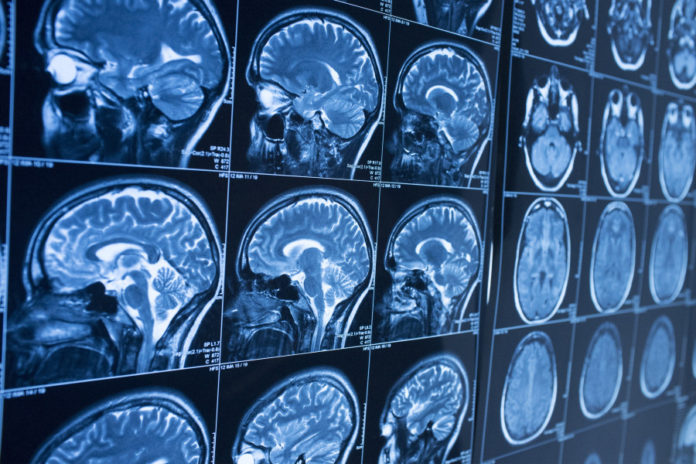The human brain functions rapidly enough that even upon being exposed to stimuli, neurons are activated, prompting subconscious reactions and, a fraction of a second later. But the speed at which we can noninvasively follow brain function using an MRI is not as impressive.
fMRI works by detecting the changes in blood oxygenation and flow that occur in response to neural activity – when a brain area is more active, it consumes more oxygen and to meet this increased demand blood flow increases to the active area. But the vascular changes fMRI measures can take up to six seconds in humans — a veritable eon in brain time.
Harvard scientists, in a new study, have unveiled a new way to track neuronal function using a technology that can pick up changes in the brain as much as 60 times faster. As reported, the technique tracks brain activity within 100 milliseconds of stimuli being applied.
Sam Patz, a physicist in the Brigham’s Department of Radiology and a professor of radiology at Harvard Medical School said, “Magnetic resonance elastography (MRE), which creates maps of tissue stiffness using an MRI scanner. MRE has been applied to a number of things, including, more recently, the brain. But no one had observed regional changes in brain-tissue stiffness in relation to neuronal activity. We didn’t even know what happened in the brain on a scale that would be reflected in an MRI scan.”
“Using this type of imaging technology to look at the lungs involves subjects breathing a special gas that’s made in the lab with a laser, and it’s a logistical nightmare to get both of the technologies going simultaneously. So we decided to start with the mouse brain instead because it didn’t involve using a special gas. We skipped the lungs and went right to the brain, and because of this exciting result we’ve stayed there ever since.”
The exciting result the team saw was that the anesthetized mouse’s auditory cortex — a part of the temporal lobe that processes information that comes in through the sense of hearing — was stiffening, and initially, no one knew why.
Patz said, “There was no reason, in the beginning, to think a stimulus would cause a change in brain stiffness. We were just looking to use normal MRE scans to measure the elasticity in a fixed state. In fact, we expected that all cortical regions of the brain would have the same stiffness and hence we wondered why that particular part of the brain was stiffer.”
Patz then realized that the loud noise from the MRI scanner was causing the auditory cortex in the anesthetized animal to stiffen. He thus conducted an experiment where he plugged one of the mouse’s ear canals with a gel. Sure enough, when he took another “elastogram” of the mouse’s brain, he could see that the auditory cortex on the hemisphere that processed sound from that ear had begun to soften.
Sinkus said, “The results were so unexpected that we had to pursue them and this observation is what sparked everything else.”
his work is the result of a very strong collaboration with the Sinkus group,” said Patz. “In fact, Professor Sinkus right now is in Oslo getting more human functional elastography data.” The team is currently studying the technique in human participants both in Boston and Europe.
To conduct the experiments, scientists also created a new apparatus to apply tiny mechanical vibrations to the mouse brain. The Sinkus team developed a new mathematical approach to calculating functional elastograms from the raw data, as well as an elastography device for humans about the size of a pack of cigarettes. It’s held up to the head using a swimming cap during the MRI to create mechanical waves that travel through the brain.
Sinkus and Patz agreed that the changes in stiffness parallel neuronal activity, allowing one to “see the brain thinking,” in Sinkus’s words, in almost real-time. The new technique is expected to have implications for diagnosing and understanding conditions in which neuronal activity may be slowed, disrupted, or rerouted, such as multiple sclerosis, epilepsy, Alzheimer’s and other forms of dementia, and even psychiatric disorders.
Patz said, “The data we are publishing was obtained in mice, but translation of this technology to humans is straightforward and initial studies are currently underway.”
Patz said, “The new technology has shown neuromechanical changes in the brain that link to neuronal activity as fast as 100 milliseconds but, We now have preliminary data that can test neuronal changes much faster, as fast as 24 milliseconds.”
He expects, too, that elastography will become much more commonplace. “We look forward to working with clinicians to applying the technique to various diseases.”
Funding for this work was provided by the National Institutes of Health, the European Union’s Horizon 2020 Research and Innovation program under grant agreement No 668039, German Research Foundation, Brigham and Women’s Hospital Department of Radiology and Boston University Department of Engineering, the Wellcome/EPSRC Centre for Medical Engineering, and the European Union Seventh Framework Programme.
Scientists have reported about their study in the journal Science Advances.
